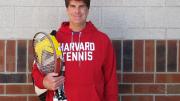This February, Tim Mayotte joined the staff of the Harvard men’s tennis team as a volunteer assistant coach, succeeding Eric Butorac. In this unpaid but significant role, Mayotte works with head coach Dave Fish '72 and associate head coach Andrew Rueb '95 to improve the level of play of the Crimson squad, recently ranked twenty-second nationally.
It is rare for any Harvard athlete to get mentoring from a player with accomplishments comparable to Mayotte’s, who attended Stanford and won the NCAA tournament in 1981. He starred on the men’s professional tour in the 1980s, attaining a world ranking as high as number seven in 1988, and getting to the semifinals at Wimbledon in 1982 and the Australian Open in 1983. He played on the U.S. Davis Cup team and won a silver medal at the 1988 Olympic Games in Seoul.
Dave Fish says having “Gentleman Tim” working with Harvard players once again is a “special treat” and brings Mayotte's Harvard association full circle. “After reaching a career high of number 7 in the world, Tim used to come by and work out with our players in the mornings when he was training in Boston under legendary coach Bill Drake [of The Country Club in Brookline], in the early ’90s,” Fish says. “Later he became a USTA [United States Tennis Association] national coach, an experience which spurred him on to become one of the finest technicians in tennis. Tim is a passionate advocate for a national coaching ‘university,’ believing that more better-trained coaches are needed to help lift American tennis back up to world prominence.”
Since retiring from professional play in 1992, “I’ve become a very technical coach,” Mayotte explains. “My main mission is to try to improve the quality of coaching in the United States, where there isn’t a great understanding of how the game has changed in the last 25 years. The American tradition has been one of very aggressive tennis—big serves, big forehands, an attacking game and shorter exchanges: it goes back to Jack Kramer. But the game has changed drastically. The two-handed backhand, the semi-Western grip, bigger racquets, and new kinds of strings that produce more spin—all these things can mean 25-ball exchanges in which offense transitions into defense, then back to offense, and so on. It’s a game that maximizes movement, and if you’re not moving in the most dynamic and efficient way, you won’t be able to recover fast enough and set up for the next ball in time.”
Another factor is the slowing down of court surfaces. In the late 1980s and early 1990s, “the points got so short that Wimbledon got scared,” Mayotte says, citing one match between Pete Sampras and Goran Ivanisevic in which the average point was only 1.2 shots long. Wimbledon changed its type of grass to a species with much deeper roots and the courts slowed down considerably. “When I played Wimbledon there was a lower bounce and the court played much faster,” he says. “Today the surfaces of clay, hard courts, and grass play much more similarly than they once did.”
Mayotte was based in Boston for 12 years while competing. He then spent 20 years in New York City after retiring, five of them as president of the Association of Tennis Professionals Players’ Council. He also earned a master’s in psychology and Christian theology at Union Theological Seminary. In 2003 he got back into tennis, taught at a private club, and was hired by USTA to run a high-performance program. He’s now a candidate for the job of director of player development at USTA.
Mayotte returned to Boston last December. (He’s a newlywed: his second wife, former Croatian tennis pro Ana Radeljevic, works in finance in Boston.) He gets to the Murr Center nearly every afternoon to work with the Crimson players, and says, “It’s a gas. The kids here are really receptive, and they are good athletes. Mostly I make technical suggestions; I bring another set of eyes to the court, along with Dave and Andrew.” He’ll often make a short video of a player hitting the ball, then play it in slow motion while discussing with the athlete how he might improve his technical execution.
He wants to strengthen both the level of play in American tennis and the level of coaching. They obviously go together. “There is no rigorous certification process for coaching here,” he says. “It takes as long to develop a great coach as a great player.”









